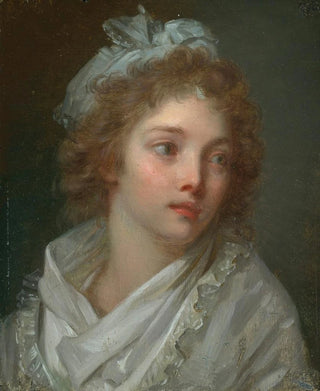Taidetuloste | Portrait d'une jeune femme - Élisabeth Louise Vigée Le Brun


Takaa näkyvä näkymä

Kehys (valinnainen)
Reproduction Portrait of a Young Woman - Elisabeth Louise Vigée Le Brun – Engaging Introduction
In the world of 18th-century painting, some artists stand out for their ability to capture the beauty and elegance of their subjects. Elisabeth Louise Vigée Le Brun is undoubtedly one of these iconic figures. Her work, the "Portrait of a Young Woman," embodies not only the spirit of her era but also a technical mastery that continues to amaze art enthusiasts. The taidetuloste of this portrait offers a unique opportunity to immerse oneself in the refined universe of the French court, where beauty and artistic skill intertwine to create timeless works.
Style and uniqueness of the work
The "Portrait of a Young Woman" is distinguished by its finesse and attention to detail. Vigée Le Brun, a true virtuoso, manages to convey an impression of life and movement through the delicacy of her model's features. Light plays a fundamental role in this composition, illuminating the face of the young woman in an almost supernatural way. The chosen colors, soft and harmonious, create an atmosphere of serenity and grace, while the sumptuous fabrics draped on the model add a tactile dimension to the work. Every element, from the penetrating gaze of the young woman to the subtle undulation of her hair, reflects a refined aesthetic pursuit, characteristic of Vigée Le Brun's art. This work is not merely a portrait but a true celebration of femininity and beauty, capturing the essence of an era where art and fashion danced in elegant harmony.
The artist and her influence
Elisabeth Louise Vigée Le Brun, one of the first women to establish herself in the world of painting, transcended the constraints of her time. Born in 1755, she quickly became the court portraitist of Marie Antoinette, earning undeniable fame. Her ability to paint portraits that combined realism and idealization influenced many artists, both of her time and subsequent generations. Vigée Le Brun not only paved the way for other women artists but also redefined the norms of female representation in

Rendu mat

Takaa näkyvä näkymä

Kehys (valinnainen)
Reproduction Portrait of a Young Woman - Elisabeth Louise Vigée Le Brun – Engaging Introduction
In the world of 18th-century painting, some artists stand out for their ability to capture the beauty and elegance of their subjects. Elisabeth Louise Vigée Le Brun is undoubtedly one of these iconic figures. Her work, the "Portrait of a Young Woman," embodies not only the spirit of her era but also a technical mastery that continues to amaze art enthusiasts. The taidetuloste of this portrait offers a unique opportunity to immerse oneself in the refined universe of the French court, where beauty and artistic skill intertwine to create timeless works.
Style and uniqueness of the work
The "Portrait of a Young Woman" is distinguished by its finesse and attention to detail. Vigée Le Brun, a true virtuoso, manages to convey an impression of life and movement through the delicacy of her model's features. Light plays a fundamental role in this composition, illuminating the face of the young woman in an almost supernatural way. The chosen colors, soft and harmonious, create an atmosphere of serenity and grace, while the sumptuous fabrics draped on the model add a tactile dimension to the work. Every element, from the penetrating gaze of the young woman to the subtle undulation of her hair, reflects a refined aesthetic pursuit, characteristic of Vigée Le Brun's art. This work is not merely a portrait but a true celebration of femininity and beauty, capturing the essence of an era where art and fashion danced in elegant harmony.
The artist and her influence
Elisabeth Louise Vigée Le Brun, one of the first women to establish herself in the world of painting, transcended the constraints of her time. Born in 1755, she quickly became the court portraitist of Marie Antoinette, earning undeniable fame. Her ability to paint portraits that combined realism and idealization influenced many artists, both of her time and subsequent generations. Vigée Le Brun not only paved the way for other women artists but also redefined the norms of female representation in






